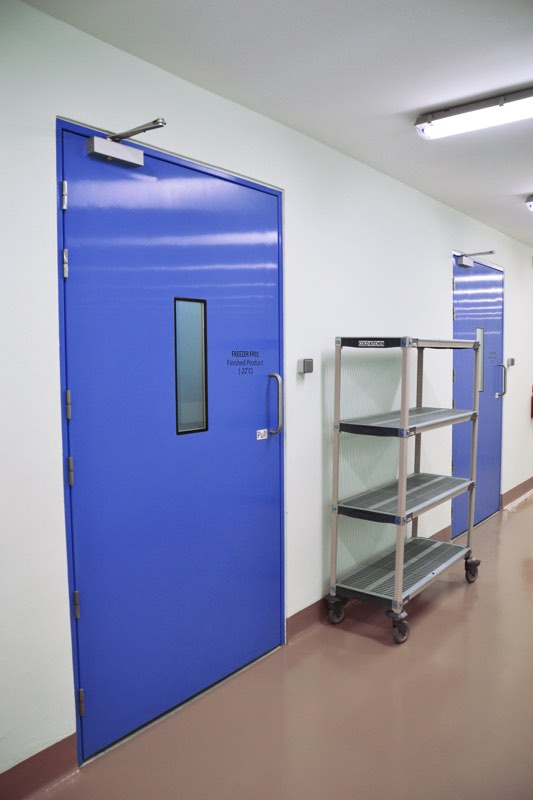Today’s hygiene regulations require food and beverage manufacturers to operate at buildings that meet specific standards in their layout, design and construction. In particular, production spaces should permit good hygiene practices, be easy to clean and disinfect, and should protect food against external sources of contamination, such as pests and bacteria.
Door systems play an essential role in preventing cross-contamination as well as maintaining correct room temperatures and ensuring optimum operating efficiency. Let's look at some of the key considerations in more detail.
Protection against pests and contaminants
Minimising any potential for contamination is one of the highest priorities in food processing facilities.
To minimise bacteria, it is essential that doors are completely seamless and impervious. This prevents germs from building up in any hard-to-clean gaps or cracks in the door's surface.
If doors start to crack, rot or peel, the exposed surface can reveal areas for bacteria to reproduce, which will compromise hygiene.
We are all well aware that surfaces in food facilities must be cleaned thoroughly and regularly. For this reason, doors must have smooth, waterproof surfaces that are easy to clean and disinfect.
They also need to be durable enough to withstand impact from traffic and vigorous cleaning procedures, which typically include very hot water, steam and aggressive cleaning chemicals.
If doors start to crack, rot or peel, the exposed surface can reveal areas for bacteria to reproduce, which will compromise hygiene.
Door selection is also an important factor in keeping the temperature levels balanced in food facilities. A door should enable easy access for goods and people while also minimising air exchange.
When ventilation and temperature are controlled, chances are, condensation, and refrigeration costs will reduce. This improves the efficiency of the building and the overall quality of the products.
Automated doors can be used in conjunction with airtight doors at the appropriate locations to offer a higher degree of air management control.
Sealing and/or automatic doors can prevent air from travelling to areas where it’s not supposed to, improving temperature control and reducing cross-contamination.
Increasing safety and productivity
Doors need to be wide enough to allow the easy movement of staff, equipment and vehicles.
Doors also need to be correctly installed, so that there are no gaps around the doors or frame. When doors are in frequent use (for example in loading bays), additional measures like automation and self-closing mechanisms may be necessary to increase opening speeds and help minimise pests.
Automatic or fast acting doors can be beneficial for high traffic areas in particular or where open food products are being transferred.
Shorter opening times can minimise draughts, dust and contamination while also increasing production efficiency and saving energy costs. Furthermore, automated doors help improve staff safety and prevent damage to the door by reducing collisions.

Automated doors help improve staff safety and prevent damage to the door by reducing collisions
High traffic areas and production spaces that are likely to have equipment and forklifts passing through require doors that are solid and able to withstand heavy impacts.
Preventative maintenance should also be considered for all doors to keep them in peak operating condition and to help prevent costly downtime throughout the facility.
Fire protection and safety areas
Fire doors are one of the most critical elements of fire protection. They are an important part of compartmentation that helps to slow down the spread of fire and smoke.
Compartmentation also allows occupants to either escape the building by keeping escape routes clear of smoke and fire or wait for rescue.
The selection and installation of fire doors, which are fire tested and proven compliant by a third party approved organisation, is essential.
A fire door is much more than just a door panel. The door panel, the frame, the hinges, the fittings, the hardware, the glass in the vision panels, and the seals are all dependent upon each other.
Working in tandem, they ensure the effectiveness of the door in a fire. The full door assembly must be fire tested as a combination of all elements together, rather than each component individually.
Fire doors are carefully engineered safety devices which should be fitted correctly by experienced installers from a reputable company. A certified fire door installed incorrectly may provide very little, if any, fire resistance at all. For this reason, specifiers should always use professional installers who are fully trained.
Choosing materials
Long-term durability and high performance are achieved by specifying the most suitable door materials.
When selecting doors, food facilities commonly have four materials to choose from: steel, timber, laminate or glass-reinforced plastic (GRP). These are also called FRP doors.
However, in areas where hygiene is important, there is really no comparison between them. In every aspect, GRP doors provide hygienic performance that is much better than their steel or timber counterparts.

Hygienic GRP doors comply with GMP requirements in the food industry
The reason is simple. The construction of steel and timber doors leaves seams and crevices, particularly around vision panels and the top and edges of doors. These harbour bacteria and are difficult to clean, creating contamination risks.
Steel doors also oxidise when exposed to regular cleaning regimes, whereas timber and laminate doors warp, rot and decay when exposed to moisture.
Lifecycle costs
Hygienic, GRP doors are also better value than its competitors when lifecycle costs are factored in.
Depending on the type of structure, steel doors will often require additional heavy steelwork to reinforce the door opening before installation. In high usage areas, doors are subject to a lot of wear and tear.
The surfaces of steel, timber and laminate doors mark very easily and require regular maintenance to ensure hygienic performance is not compromised. Also, should they suffer impact damage, they can easily dent, and cannot be repaired in situ.
Hygienic access solutions such as the range manufactured at Dortek, have become a product of choice for food facilities to overcome the limitations of other doors.
Hygienic GRP doors comply with all the latest good manufacturing practice (GMP) requirements in the food industry. These doors are designed and built to have a smooth, seamless construction, which is easy to clean and does not harbour bacteria.
The inorganic GRP door surface and core is also completely water resistant and does not warp, rust or rot when exposed to disinfectants. Doors can also be supplied and installed with numerous choices of automation, access control and airtight sealing choices to suit each opening.
In addition, a wide variety of colours are available for both door and frame, ensuring colour matching throughout the facility.
N.B. This article is featured in the April 2019 issue of Cleanroom Technology.
The digital edition is available online.